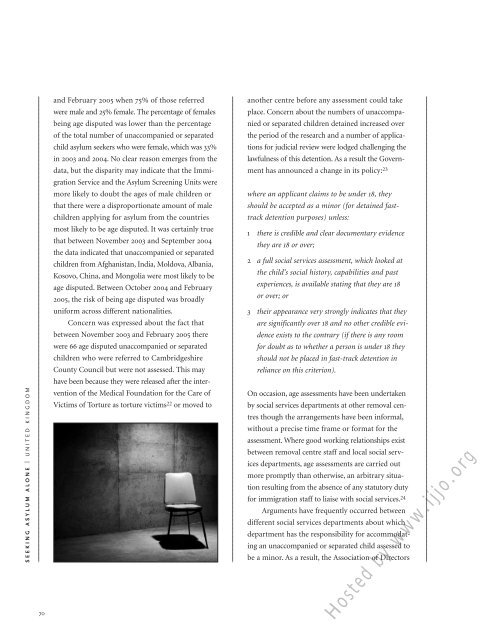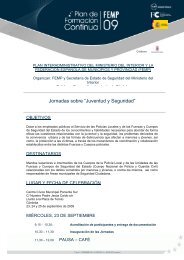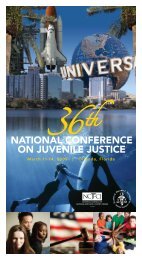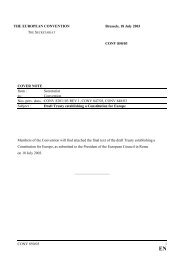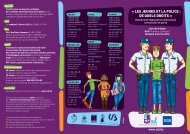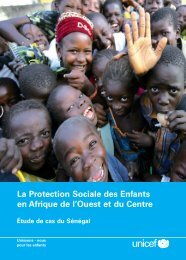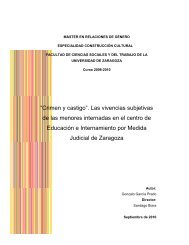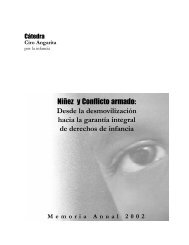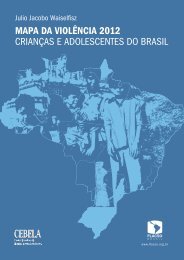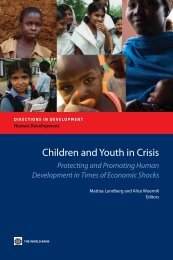Hosted by www.ijjo.org
Hosted by www.ijjo.org
Hosted by www.ijjo.org
Create successful ePaper yourself
Turn your PDF publications into a flip-book with our unique Google optimized e-Paper software.
and February 2005 when 75% of those referred<br />
another centre before any assessment could take<br />
were male and 25% female. The percentage of females<br />
place. Concern about the numbers of unaccompa-<br />
being age disputed was lower than the percentage<br />
nied or separated children detained increased over<br />
of the total number of unaccompanied or separated<br />
the period of the research and a number of applica-<br />
child asylum seekers who were female, which was 33%<br />
tions for judicial review were lodged challenging the<br />
in 2003 and 2004. No clear reason emerges from the<br />
lawfulness of this detention. As a result the Govern-<br />
data, but the disparity may indicate that the Immi-<br />
ment has announced a change in its policy: 23<br />
gration Service and the Asylum Screening Units were<br />
more likely to doubt the ages of male children or<br />
where an applicant claims to be under 18, they<br />
that there were a disproportionate amount of male<br />
should be accepted as a minor (for detained fast-<br />
children applying for asylum from the countries<br />
track detention purposes) unless:<br />
most likely to be age disputed. It was certainly true<br />
that between November 2003 and September 2004<br />
the data indicated that unaccompanied or separated<br />
children from Afghanistan, India, Moldova, Albania,<br />
Kosovo, China, and Mongolia were most likely to be<br />
age disputed. Between October 2004 and February<br />
2005, the risk of being age disputed was broadly<br />
1 there is credible and clear documentary evidence<br />
they are 18 or over;<br />
2 a full social services assessment, which looked at<br />
the child’s social history, capabilities and past<br />
experiences, is available stating that they are 18<br />
or over; or<br />
uniform across different nationalities.<br />
Concern was expressed about the fact that<br />
between November 2003 and February 2005 there<br />
were 66 age disputed unaccompanied or separated<br />
children who were referred to Cambridgeshire<br />
County Council but were not assessed. This may<br />
have been because they were released after the inter-<br />
3 their appearance very strongly indicates that they<br />
are significantly over 18 and no other credible evidence<br />
exists to the contrary (if there is any room<br />
for doubt as to whether a person is under 18 they<br />
should not be placed in fast-track detention in<br />
reliance on this criterion).<br />
SEEKING ASYLUM ALONE | UNITED KINGDOM<br />
70<br />
vention of the Medical Foundation for the Care of<br />
Victims of Torture as torture victims 22 or moved to<br />
On occasion, age assessments have been undertaken<br />
<strong>by</strong> social services departments at other removal centres<br />
though the arrangements have been informal,<br />
without a precise time frame or format for the<br />
assessment. Where good working relationships exist<br />
between removal centre staff and local social services<br />
departments, age assessments are carried out<br />
more promptly than otherwise, an arbitrary situation<br />
resulting from the absence of any statutory duty<br />
for immigration staff to liaise with social services. 24<br />
Arguments have frequently occurred between<br />
different social services departments about which<br />
department has the responsibility for accommodating<br />
an unaccompanied or separated child assessed to<br />
be a minor. As a result, the Association of Directors<br />
<strong>Hosted</strong> <strong>by</strong> <strong>www</strong>.<strong>ijjo</strong>.<strong>org</strong>


